BLOG
6 Tips On How to Sell Luxury Items Online
Published: Oct 12, 2020
How to avoid crucial mistakes when selling luxury items online? In our blog post, we look at 5 strategies that will ensure your luxury marketing is on-point and sales-oriented.
By the year 2025, online luxury sales will have tripled their contribution to the global high-end market, exceeding $91 billion and accounting for 20% of all luxury sales made. This is because of an operating model the consulting corporation McKinsey refers to as ‘Luxury 4.0’.
In Luxury 4.0, luxury brands and retailers leverage data to better understand their customers, identify emerging preferences, and streamline the processes of transforming ideas into products.
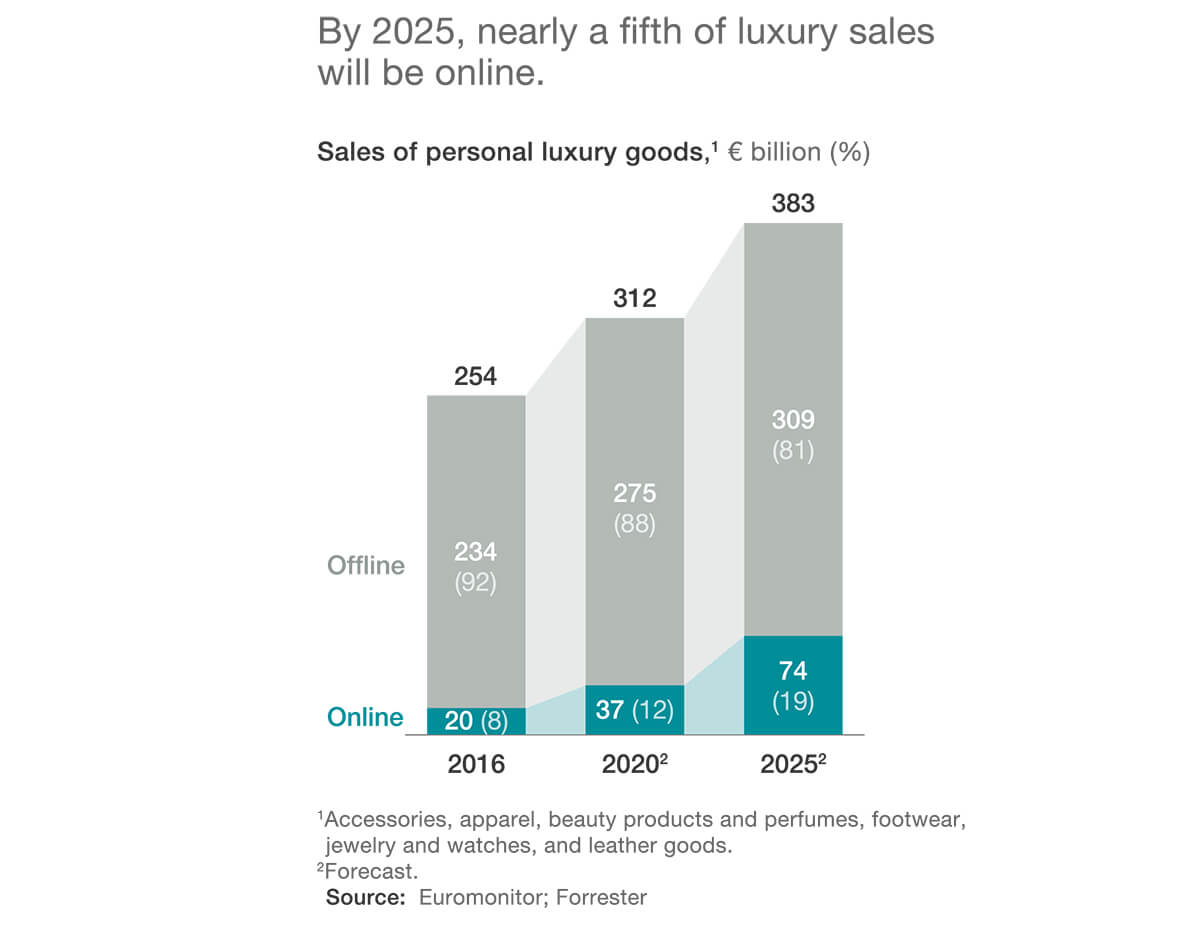
Increasingly, online shopping and digital experiences are having greater impacts on how consumers choose to purchase luxury goods.
McKinsey estimates that around 80% of luxury items bought online today are heavily digitally influenced, with consumers engaging with up to 15 digital touchpoints in their luxury purchasing journeys.
In part, this could be attributed to the generational shift that has begun to take place throughout the luxury market. Whereas before older shoppers were the target audience of luxury retailers, newer, affluent Millennial buyers, born between 1981 and 1994, and Generation Z consumers, born between 1995-2010, are now accounting for around 40% of all luxury purchases.
In 2019 alone, Millennials and Generation Z consumers generated 100% of all global luxury industry growth.
With both generations now driving sales of luxury goods, and both having grown up in the age of constantly evolving digital technological advancements, luxury eCommerce retailers have never been better placed to take advantage of, and optimize for, the digital market.
When it comes to selling luxury goods online, there are lessons to be learned from luxury fashion retailers like Net-A-Porter and Farfetch, two brands that have both successfully embraced digital luxury retail.
FarFetch especially accredits its early adoption of technology – most notably, personalization – in its establishment as a market leader. Meanwhile, Net-A-Porter revolutionized high-end retail by incorporating mobile and artificial intelligence technologies alongside data-driven strategies into its brand identity.
In this article, we’ll break down on how to sell luxury products online using five simple steps luxury eCommerce retailers can implement immediately into their luxury marketing and sales strategies.
6 Tips on How to Sell Luxury Items Online
1. Use personalization to drive incremental sales
In its Global Powers of Luxury Goods research, Deloitte noted that the rise of eCommerce and the availability of digital channels accessible to luxury brands were creating a consumer need for both large-scale and high-quality personalized content.
Nowadays, consumers want to be treated as individuals, and this need is intensified when it comes to making high-value purchases.
One way Net-A-Porter personalize their shopping experience is by offering EIP memberships. EIP (Extremely Important People) members unlock special privileges including a personal shopper that delivers the luxury goods to a home address, waits until the products have been tried on, and then collects any items that need to be returned.
There are also pre-order services, abilities to shop new products 36 hours before they become available to other shoppers, private sales, and surprise gifts available to EIP members.
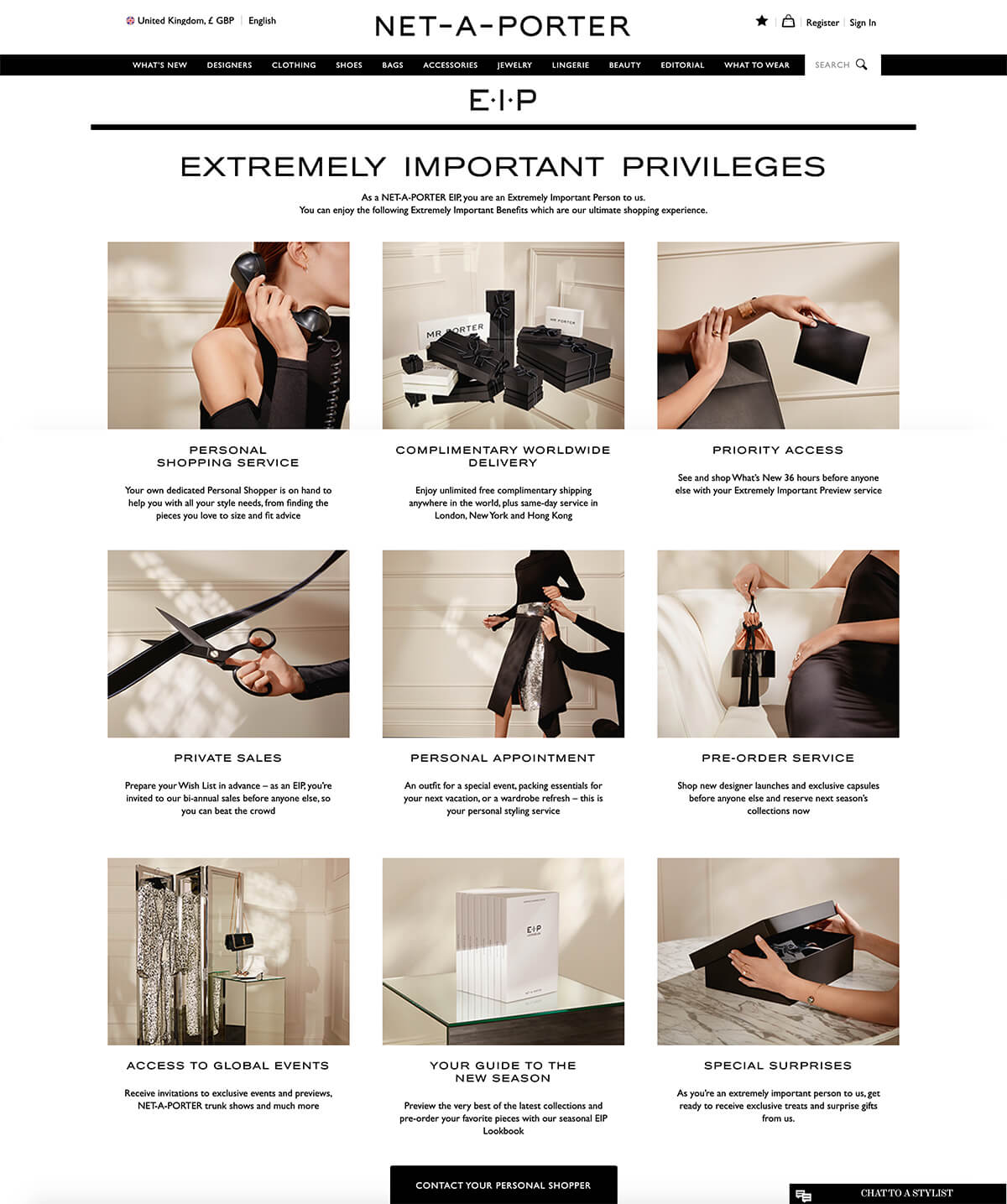
To become an EIP, however, it is rumored that members must have accrued around $70,000 in sales across a 12 month period. Incredibly, whilst Net-A-Porter’s EIP’s only make up 2% of its consumer base, they generate 40% of its sales.
Luxury eCommerce retailers can take advantage of this high-end consumer desire and follow by Net-A-Porter’s example, even if they are only a small to medium-size business.
Segmenting audiences by their lifetime consumer value and then advertising select sales or early shopping opportunities to the highest-ranked consumers could be one way to encourage other customers to make similar purchases in order to unlock the same privileges.
Alternatively, simply offering attention-focused customer service across the board could ensure your fashion eCommerce stands out from competitors by highlighting consumer individualism as a key-value and subsequent USP. Net-A-Porter also does this by advertising 24/7 Fashion Consultants.
When selling luxury products online, cross-sell strategies that recommend products to consumers based on their previous purchases, cart or wish list items could also be effective in delivering a standout, individualized experience.
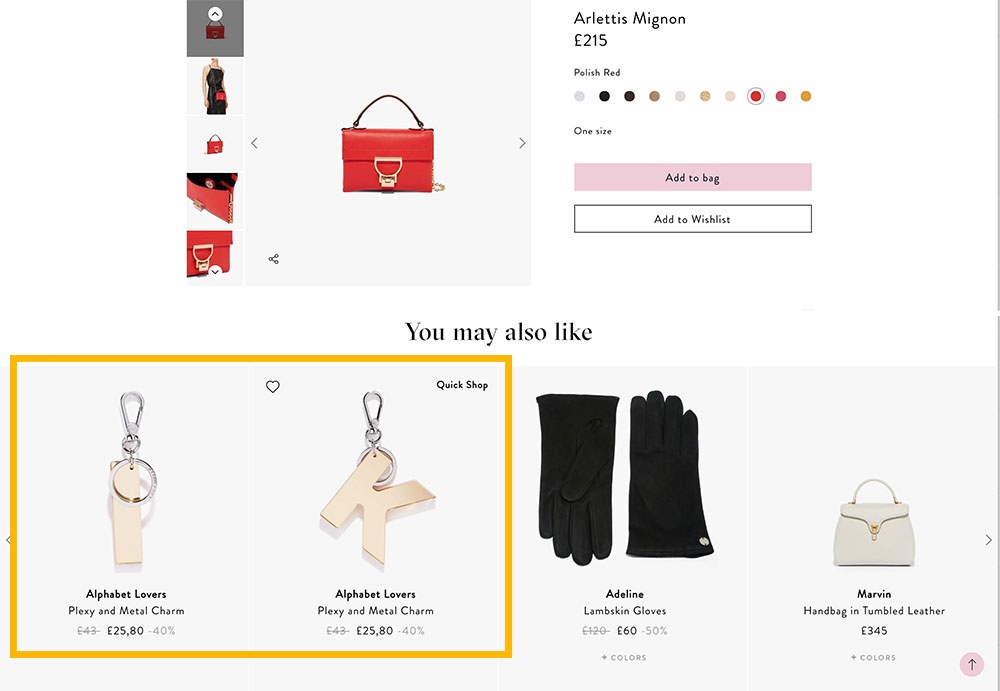
Consumers who are greeted with a personalized experience are known to spend more and are more likely to become loyal customers, leading to repeat purchases and higher LTV.
Finally, social proof tools are another type of personalization that can help you increase on-site conversions.
2. Unify online and offline experiences
Whilst digital channels and the rise of online shopping are driving factors in the disruption of brick and mortar sales, luxury consumers are still driven in-store because of brand experiences.
Many luxury goods require an element of in-person service that can’t always be replicated online with e-commerce: Expert measurement and fitting, tailoring, customization, etc.
Stores like Gucci and Bvlgari offer shoppers plush, uniquely designed showrooms, jewelry maker Tiffany’s lets you advise with a diamond expert and customize engagement rings to your liking, whilst Burberry goes one step further by partnering with Uber to help transport customers to their nearest store.
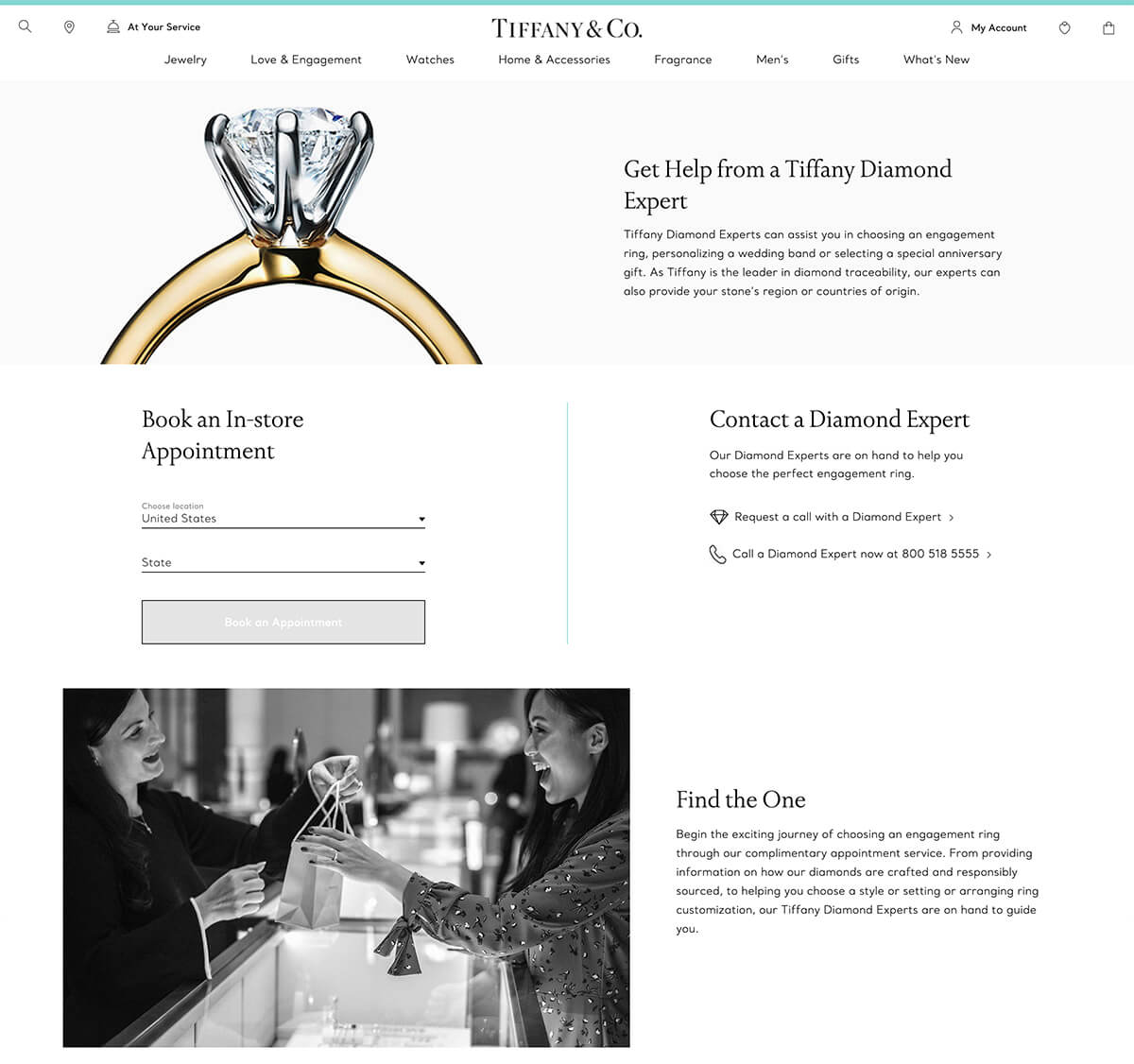
To drive visitors into stores where they could become consumers once satisfied with having had a luxury shopping experience, it’s important to unify the connection between an online and offline presence. This is known as the reverse omnichannel strategy.
Using a search engine optimization strategy known as geotargeting, you can suggest local stores to visitors upon their arrival to your site and could be one way to direct them into a brick and mortar store.
Likewise, offering buy online pick up in-store (BOPIS) services with distinct CTAs across landing and product pages, or highlighting exclusive, only available in-store products could encourage in-person shopping.
3. Clearly signal your value
Value proposition doesn’t just extend to the benefit that your product will have on a consumer’s daily life. It also includes your brand.
Products from high-end retailers are automatically regarded as high-quality and worth their money because of the luxurious connotations associated with their brand. For example, if a luxury retailer uses higher quality materials than any other brand, this is part of the perception that consumers of the brand buy into when purchasing their products.
See how Dior instills value in their product by showcasing the unique process that goes into making each handbag:
Just like how storytelling is a key component of any marketing, if your brand is built from a particular heritage, or history, tell this story through prominently displaying your value signals or insignias throughout your online experience.
4. Tell your story on social media
Social media can play a crucial role in helping luxury eCommerce retailers convert visitors to consumers. An example of a successful luxury marketing campaign on social media was Burberry’s ‘Tale of Thomas Burberry’ shot by Oscar-winning filmmaker Asif Kapadia.
The microfilm featured prominent acting stars like Lily James and Domhnall Gleeson and depicted the life, struggles, and entrepreneurship of Thomas Burberry, the brand founder.
The film was posted firstly on the brand’s Facebook page before it went viral, generating over 15 million views and being hailed as one of the best holiday season advertisements of all time.
For Burberry, the popularity of the film worked across multiple levels. The video generated mass engagement whilst also helping to cement the brand’s identity and USPs in viewers’ minds. All the items worn in the film were available to buy at Burberry’s store, advertising the products again, and again, across multiple channels, to multiple viewers.
Luxury eCommerce stores can therefore use storytelling to not only engage copious visitors and potential consumers with their brand identity but to also generate engagement with their products.
By advertising the story behind the manufacturing of certain products, visitors may be likely to invest in the perception and may visit the site to learn more about the luxury product being advertised.
5. Invest in content
As a natural accompanier to storytelling and social media marketing, pouring resources into high quality, relevant content can drive sales from both existing and new consumers.
The benefit high-quality content marketing gives luxury brands is its ability to communicate the elevated level of the brand’s aesthetic to the designated target audience throughout its language and appearance.
Content can take the form of informative blogs, well-produced videos, in-depth guides, and even emails and must give off the same feeling as handling a glossy, luxury brochure.
Louis Vuitton produces in-depth city guides that it hails as Magazines (also available in mobile app format). These guides promote insider tips as to the best places to visit in a city that isn’t necessarily featured in tourist publications. At the same time, as advertising these revered spots, the guide does of course suggest which fashion pieces would complement which outfit, and which outfit would be best to be worn where.
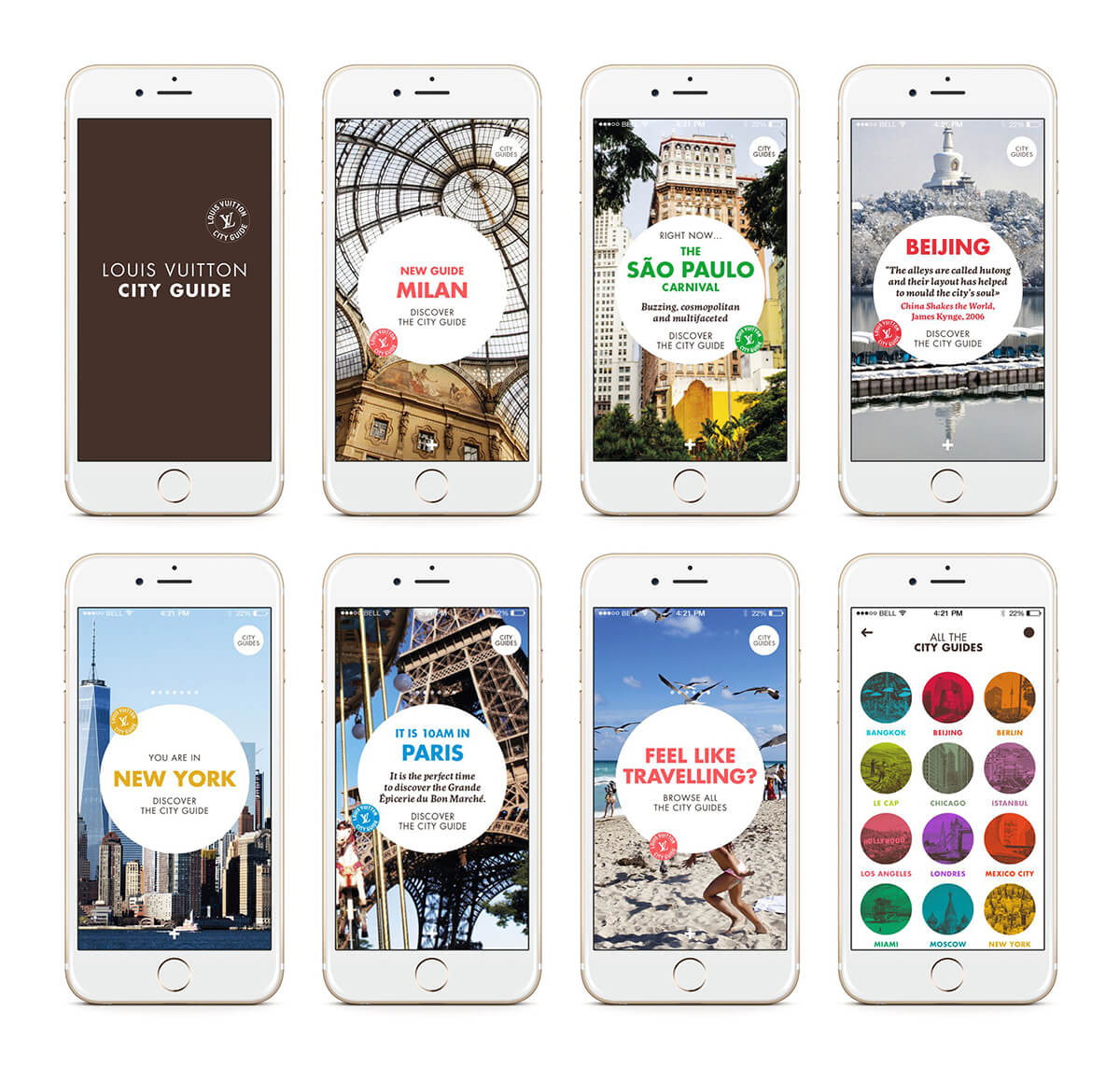
These exclusive guides are not only sought after by their audience, they are bought too – at the price of $25 an edition. They work effectively because Louis Vuitton knows their audience seeks insider knowledge and this feeling of exclusivity is vital for high-end brands to capitalize on when selling luxury.
Producing content that promotes uniqueness and has a sense of insider sheen will resonate with and then engage high-end buyers. For eCommerce retailers, one example in peak holiday season could be to release a Gift Guide that offers exclusive insight into the products that will be Christmastime best sellers. You could also adopt a similar tactic in the build up to Valentine’s Day.
As a multichannel content marketing strategy, following the release of that guide with an email marketing sequence or blog content series that takes particular products and focuses on their USPs will issue repeated, non-pushy reminders, and may drive purchases when combined with CTAs.
6. Provide Exceptional Customer Service
Customers looking to buy luxury good, whether is designer clothing, watches, shoes or accessories will all want a very good level of customer service. This can be online via your website or in a retail store.
If they are willing to pay a premium for a product they have every right to expect to be given premium customer service.
While it may be difficult to translate exclusive experiences in-store into eCommerce, there are ways that this can still happen. For example, live chats allow you the opportunity for personal styling advice and a more personalised buying experience from websites.
So if your online customer base deserves attention then give them what they want by being empathetic and responsive towards all types of feedback received. You’ll need to ensure you have quick response times and can hopefully solve any issues as quickly as possible.
So whether the complaints come through social media platforms, or if it’s feedback from surveys about their experience with your company’s products/services. You need to take it all into account.
Challenges When Selling Luxury Products Online
Whilst there will be specific challenges luxury brands will face, when selling online the “normal” issues will still be there, and may even be amplified. Below are three that would be worth addressing.
Basket Abandonment: You will have some customers who simply abandon their baskets. This is a well established fact within the world of eCommerce. So you need to make sure you are set up to counter this. Remarketing ads, basket abandonment solutions, personalization etc can all help reduce this.
Delivery: If customers are spending a considerable amount of money online they need to feel 100% confident their purchase will get to them quickly, and in one piece. This is why a reliable delivery partner is vital. It may also be worth showcasing delivery options and timeframes for peace of mind.
Advertising to the right audience: If your using advertising channels such as Facebook, Google Ads, or even YouTube to drive traffic to your website be very careful with the people you target. For example in Google Ads, you’ll want to avoid bidding on, and probably add negative keywords like “cheap” or “affordable”. Likewise when building an audience on Facebook try and build on that would focus on high-income individuals.
Where to sell luxury items online
Creating luxury brands takes time and consistency. But there are other ways you can sell luxury items online in the meantime.
1) Create your own website – Your own website should eventually be the main place where your sales are coming from. If you’re advertising online this is the place you’re going to be sending them so you need to make sure it’s ready to convert and
2) Reach out to high-end department stores – If you know where your ideal customers regularly shop it makes sense to try and get in front of them here. This could be both online and in store. Department stores such as Harrods and Selfridges could be prime targets. But if you’re just starting out you might be better off identifying smaller local stores that may wish to list your luxury items.
3) Look to sell via online platforms – Online market places such as, Current Boutique, Poshmark and ThredUp could be great places to start selling your luxury goods.
Luxury marketing case study: Turnbull and Asser
Turnbull and Asser is a bespoke shirtmaker, clothier, and tie maker established all the way back in 1885. Perhaps unsurprising for the first brand to receive the Prince of Wales’ Royal Warrant, it has a strong commitment to product excellence and impeccable service, whether from its flagship store on London’s Jermyn Street, online, or with its partners around the world.
Turnbull and Asser used the Yieldify Conversion Platform to create and deploy onsite messaging, generating new leads, increasing conversions, and improving the overall site UX. Read the full Turnbull and Asser case study here.
Key takeaways
Hopefully, our tips above will provide you with some useful ideas when it comes to selling luxury items online. Results in this area can take time as you will need to build your brand image and customer base.
Like what you’ve seen here? Download our free ‘Luxury eCommerce Blueprint’ eBook, featuring the luxury eCommerce cheat sheet, to get even more tips and advice on digital marketing and selling luxury goods online.
Luxury marketing FAQs
The best ways to sell luxury items online are to avoid site-wide discounting, making your value signals clear, providing exceptional customer service, and making your service personal.
The price of luxury items or products should reflect the key messages of the brand; high quality, heritage, and exclusivity.